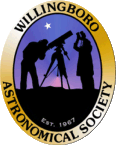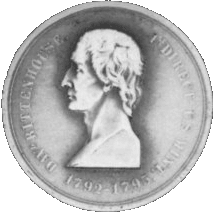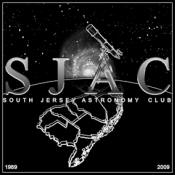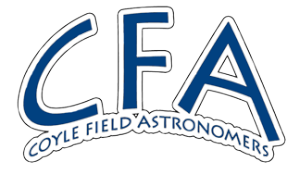Partial Solar Eclipse... not
October 23, 2014
On October 23, 2014, a partial solar eclipse would have been briefly visible from the Philadelphia area had the weather cooperated. First contact was at 5:51 pm EDT when the setting sun was at 3° altitude, with sunset 18 minutes later at 6:09 pm, at which time the moon had ingressed about 20% of the solar diameter. Towards sunset, there were some brighter gaps in the clouds, prompting a visit to Swede Run Fields in Moorestown, NJ, just in case the sun appeared. Alas, it never did, but a passing skein of geese provided this scenic picture in the direction of the unseen sun, which would have been at the tree tops near the center of the frame width. Taken at 5:55 pm with a Canon EOS 6D digital SLR camera and a Canon 70-200 mm f/2.8L zoom lens (on a fixed tripod) set to 200 mm focal length. Exposed 1/500 second at f/5, ISO 400.
Total Lunar Eclipse
October 8, 2014
On October 8, 2014, there was a total lunar eclipse during morning twilight. First umbral contact was at 5:15 am EDT, totality began at 6:25 am and mid-eclipse was at 6:55 am. However, local sunrise was at 7:03 am and the moon set at 7:08 am, before the end of totality at 7:24 am. This image was captured from Swede Run Fields in Moorestown, NJ, at 6:27 am, two minutes after the start of totality when the moon was at 7° altitude, and 9 minutes before the start of civil twilight. Taken with a Canon EOS 6D digital SLR camera and a Canon 70-200 mm f/2.8L zoom lens (on a fixed tripod) set to 200 mm focal length. It was exposed one second at f/5.6, ISO 800. More eclipse photos here.
Saturn and the Crescent Moon
September 27, 2014
On September 27, 2014, the planet Saturn was only 3° from the 3.7-day-old, 13% illuminated crescent moon. This image was captured at 7:11 pm EDT, 23 minutes after sunset (at 6:48 pm) from the grounds of Tatem Observatory at Camp Ockanickon in Medford, NJ. At the time, Saturn was not yet visible to the unaided eye, but it was visible in in a magnified version of this this image (mouseover for a 30% crop of the original frame; Saturn is at the upper left). Taken with a Canon EOS 6D digital SLR camera (on a fixed tripod) and a Canon 100 mm f/2.8L macro lens. This is a single exposure of 1/50 second at f/2.8, ISO 400; uncropped.
Saturn had become plainly visible when the image below was was captured at 7:35 pm EDT (47 minutes after sunset). At the time, Saturn was at 13° altitude and the earthshine-filled moon was at 11½° altitude. Taken with the same camera and lens, but cropped to 70% of the original frame. This is a single exposure of one second at f/2.8, ISO 400. Mouseover for a close-up crop of the pair (30% of the original frame). In the close-up view, Nu Librae is the brighter star (magnitude 5.2) roughly midway between Saturn and the moon.
Aurora... not
September 12, 2014
Because of a powerful solar flare a couple of days earlier, there was a possibility of seeing aurorae from our area on September 12, 2014. Several observers from the Willingboro Astronomical Society ventured to Coyle Field in Woodland Township, NJ, for a look before moonrise at 9:31 pm EDT. Unfortunately, I didn't arrive until 10:45 pm when the last of them was about to lock the gate on the way out. Since I was already there, I decided to stay for a while. Besides interference from the moon, about 80% illuminated, the sky was somewhat cloudy. However, stars were visible through thinner clouds and in patches of clearing. I was even able to spot Uranus and Neptune with my 16x70 binoculars, but I wasn't able to see comet C/2014 E2 (Jacques), about 3° northeast of Albireo. Besides interference from the moon and clouds, Jacques has really faded since perigee on August 28th, so the negative sighting shouldn't be surprising. In any case, there were no aurora sightings by me or the earlier crew. The image above (looking generally north) was captured at 11:52 pm with a Canon 6D digital SLR camera (on a fixed tripod) and a Canon 24-105 mm, f/4L zoom lens set to 24 mm. It was exposed 2 seconds at f/4, ISO 12,800. Mouseover for labels.
The image below shows the Summer Triangle overhead, taken at 11:29 pm through a gauze of cloudiness. Same camera, lens and focal length; exposed 4 seconds at f/4, ISO 12,800. Mouseover for labels.
The following image looks south (towards Atlantic City, 30 miles away) at 11:32 pm and shows Fomalhaut approaching the meridian, while Capricornus is mostly past it. Same camera, lens and focal length; exposed 2 seconds at f/4, ISO 12,800. Mouseover for labels.
Comet C/2014 E2 (Jacques)
August 26, 2014
Comet C/2014 E2 (Jacques), in the constellation Cepheus, was captured on August 26, 2014, at 10:33 pm EDT from Coyle Field in Woodland Township, NJ, using a Canon EOS 6D digital SLR camera (on a fixed tripod) and a Canon 100 mm f/2.8L macro lens. This is a single exposure of 6 seconds at f/4, ISO 6400, and is a three-quarters crop of the original frame. Comet Jacques will be at perigee on August 28, 2014, so it was moving rapidly against the starry background (about 3.5° per day when the picture was taken). Mouseover for labels.
The image below is a one-quarter crop of the original frame.
Click here for some older images.



